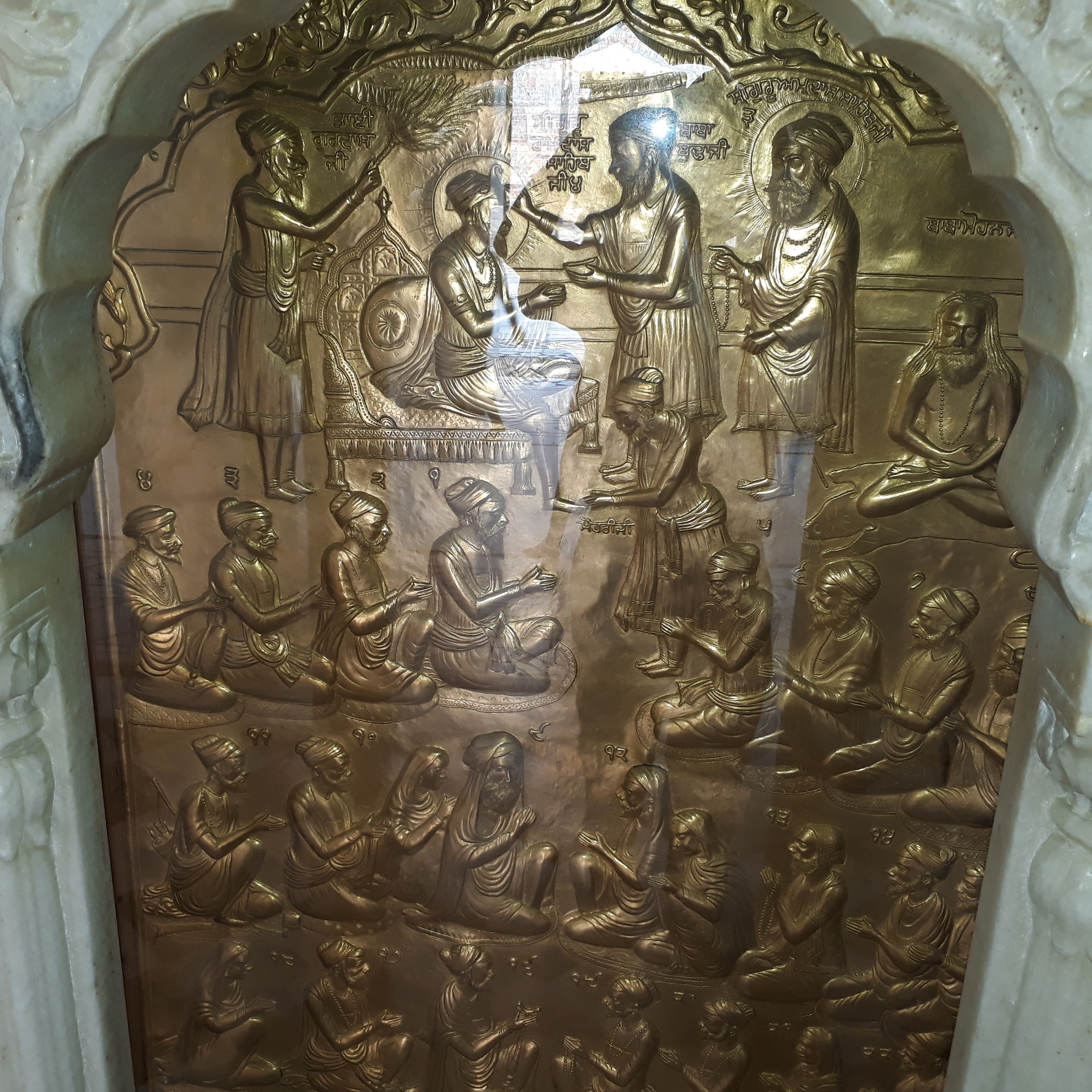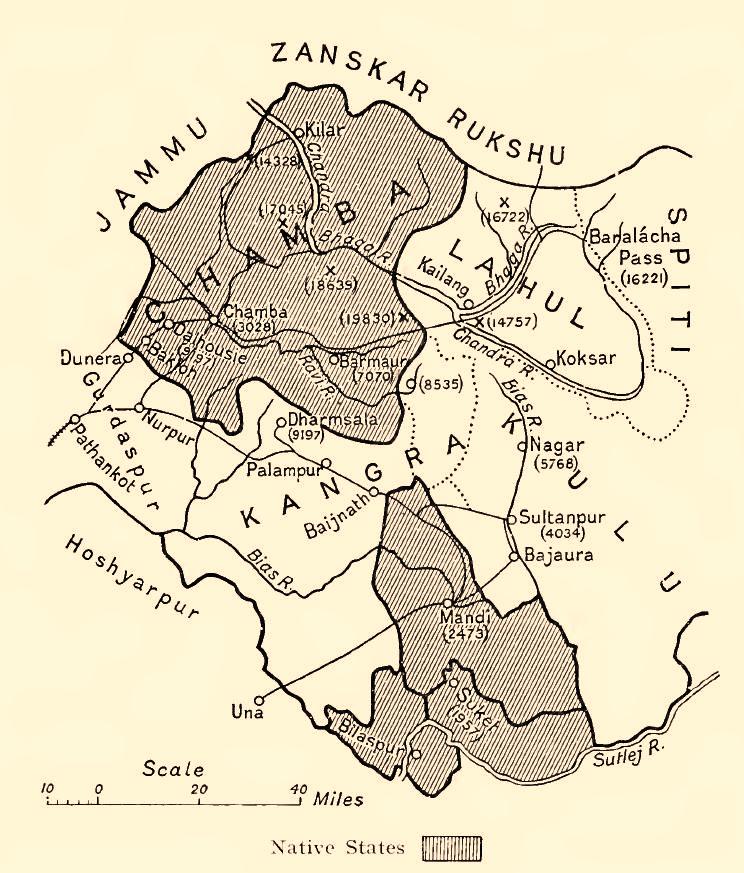|
Gangushahi
Gangushahi is a Sikh sect that is mostly found in the Shivalik Hills region. History The Gangushahi sect that can be traced back to Gangu Shah, also known as Gangu Das, whom was a manji preacher assigned by Guru Amar Das to the Shivalik Hills region, being given a seat in the Sirmur region. Gangu Shah had been born into a Basi Khatri family in Garhshankar. According to Sikh lore, Gangu had presented four pice weight of ''gur'', all of his material possessions, to Guru Amar Das before the guru dispatched him to on the preaching mission to the Shivalik Hills. Over-time, his preaching attracted many followers, with the group growing into their own order. The great-grandson of Gangu, Javahar Singh, consolidated a new sect of Sikhs based on the following of Gangu. During this time, the Gangushahi leader Javahar Singh commanded a large force in the hills region. The Gangushahis constructed their own shrines at Daun (near Kharar in Ropar district), which had been built under Gangu ... [...More Info...] [...Related Items...] OR: [Wikipedia] [Google] [Baidu] |
Sects Of Sikhism
Sikh sects, denominations, traditions, movements, sub-traditions, also known as ''Sampradaya, sampardai'' (Gurmukhi: ਸੰਪਰਦਾ; ''saparadā'') in the Punjabi language, are sub-traditions within Sikhism that with different approaches to practicing the religion. ''Sampradas'' believe in one God in Sikhism, God, typically rejecting both idol worship and castes. Different interpretations have emerged over time, some of which have a living teacher as the leader. The major traditions in Sikhism, says Harjot Oberoi, have included Udasi, Nirmala (sect), Nirmala, Nanakpanthi, Khalsa, Sahajdhari, Namdhari Kuka, Nirankari, and Sarvaria. During the persecution of Sikhs by Mughals, several splinter groups emerged, such as the Mina (Sikhism), Minas and Ramraiyas, during the period between the death of Guru Har Krishan and the establishment of Guru Tegh Bahadur as the ninth Sikh Guru. These sects have had considerable differences. Some of these sects were financially and administrative ... [...More Info...] [...Related Items...] OR: [Wikipedia] [Google] [Baidu] |
Shivalik Hills
The Sivalik Hills, also known as Churia Hills, are a mountain range of the outer Himalayas. The literal translation of "Sivalik" is 'tresses of Shiva'. The hills are known for their numerous fossils, and are also home to the Soanian Middle Paleolithic archaeological culture. Geography The Sivalik Hills are a mountain range of the outer Himalayas that stretches over about from the Indus River eastwards close to the Brahmaputra River, spanning the northern parts of the Indian subcontinent. It is wide with an average elevation of . Between the Teesta River, Teesta and Raidāk Rivers in Assam is a gap of about . They are well known for their Neogene and Pleistocene aged vertebrate fossils. Geology Geologically, the Sivalik Hills belong to the Tertiary period, Tertiary Deposition (geology), deposits of the outer Himalayas. They are chiefly composed of sandstone and Conglomerate (geology), conglomerate rock formations, which are the solidified Detritus (geology), detritus of the ... [...More Info...] [...Related Items...] OR: [Wikipedia] [Google] [Baidu] |
Manji (Sikhism)
A Manji (Punjabi: ਮੰਜੀ ਪ੍ਰਥਾ ) was a Sikh religious administrative unit, similar to a parish or diocese, for the propagation of Sikhism. It was part of the Sikh missionary administrative organization founded by Guru Amar Das, the third Guru of Sikhism. Etymology The word ''Manji'' or ''Manja'' literally means a cot (taken as the ''seat of authority'' in this context). History Origin Guru Nanak would arrange early Sikh followers into various ''sangat'' (congregations) or parishes and instructed them to erect a '' dharamsal'' dedicated to spreading their Guru's message and teachings in their local area. Sangatia Sangatia (also spelt as ''Sangtias'') were head leaders from the local Sikh congregation (''sangat'') who arose as local leaders based upon personal piety and merit. Anyone could arise to become a Sangatia as there was no established priestly or clergy-class in Sikhism, as long as they were well-learnt and dedicated enough to the religion. Mos ... [...More Info...] [...Related Items...] OR: [Wikipedia] [Google] [Baidu] |
Sivalik Hills
The Sivalik Hills, also known as Churia Hills, are a mountain range of the outer Himalayas. The literal translation of "Sivalik" is 'tresses of Shiva'. The hills are known for their numerous fossils, and are also home to the Soanian Middle Paleolithic archaeological culture. Geography The Sivalik Hills are a mountain range of the outer Himalayas that stretches over about from the Indus River eastwards close to the Brahmaputra River, spanning the northern parts of the Indian subcontinent. It is wide with an average elevation of . Between the Teesta and Raidāk Rivers in Assam is a gap of about . They are well known for their Neogene and Pleistocene aged vertebrate fossils. Geology Geologically, the Sivalik Hills belong to the Tertiary deposits of the outer Himalayas. They are chiefly composed of sandstone and conglomerate rock formations, which are the solidified detritus of the Himalayas to their north; they are poorly consolidated. The sedimentary rocks comprising the ... [...More Info...] [...Related Items...] OR: [Wikipedia] [Google] [Baidu] |
Sirmur State
Sirmur (also spelled as Sirmor, Sirmaur, Sirmour, or Sirmoor) was a princely state of India, located in the region that is now the Sirmaur district of Himachal Pradesh. The state was also known as Nahan, after its main city, Nahan. The state ranked predominant amongst the Punjab Hill States. It had an area of 4,039 km2 and a revenue of 300,000 rupees in 1891. History Origin According to Mian Goverdhan Singh in ''Wooden Temples of Himachal Pradesh'', the principality of Sirmaur was founded in the 7th to 8th century by Maharaja of Parmar Rajputs, and Rathore noble. Nahan State Nahan, the predecessor state of Sirmur, was founded by Soba Rawal in 1095 AD who assumed the name Raja Subans Prakash. Near the end of the 12th century in the year 1195, a flood of the Giri River destroyed the old capital of Sirmaur-Tal, which killed Raja Ugar Chand. A ruler of Jaisalmer, Raja Salivahana, thought this was an opportune time to attack the state as it was in a state of disa ... [...More Info...] [...Related Items...] OR: [Wikipedia] [Google] [Baidu] |
Garhshankar
Garhshankar is a city in Hoshiarpur district in the state of Punjab, India India, officially the Republic of India, is a country in South Asia. It is the List of countries and dependencies by area, seventh-largest country by area; the List of countries by population (United Nations), most populous country since .... History Garshankar was founded by Doad Rajput king named Shankar Sahai at around 1000 AD, later his -kila- was destroyed by western conquerors. Garhshankar was converted as a Tehsil in the year of 1844 by the British administration. More information is available in census and 1904 Hoshiarpur report. Politics Jai Krishan Singh Rouri, (AAP) is the second term MLA from Garhshankar Assembly Constituency, elected in 2022 Punjab Assembly Elections. He was first elected as MLA in 2017 Punjab Assembly Elections. Demographics As per 2011 Census, Garhshankar had a population of . Males constitute 52% of the population and females 48%. Garhshankar has an aver ... [...More Info...] [...Related Items...] OR: [Wikipedia] [Google] [Baidu] |
Paisa
Paisa (also transliterated as ''pice'', ''pesa'', ''poysha'', ''poisha'' and ''baisa'') is a monetary unit in several countries. The word is also a generalised idiom for money and wealth. In India, Nepal, and Pakistan, the ''paisa'' currently equals of a rupee. In Bangladesh, the ''paisa'' equals of a Bangladeshi taka. In Oman, the ''baisa'' equals of an Omani rial. Etymology The word ''paisa'' is from the Sanskrit term ''padāṁśa'' (, basic unit), meaning 'quarter part base', from ''pada'' () "foot or quarter or base" and ''aṁśa'' () "part or unit". The pesa was also in use in colonial Kenya. The colloquial term for money in Burmese, ''paiksan'' (), is derived from the Hindi term ''paisa'' (). History Chaulukya coins were often called "Gadhaiya Paise" (9th–10th century CE). Until the 1950s in India and Pakistan (and before 1947 in British India), the paisa (back then spelled as ''pice'' in English) was equivalent to 3 pies, of an anna, or of a rupee. After the t ... [...More Info...] [...Related Items...] OR: [Wikipedia] [Google] [Baidu] |
Hill States Of India
The Hill States of India were princely states lying in the northern border regions of the British Raj, British Indian Empire. The historic terms ''Punjab Hills'' and ''Pahari Hills'' were used to describe the foothills of the Western Himalayan-range prior to the independence of India in 1947. History Punjab Hills Prior to the late 1940s, the region that is now classified as Jammu division, Jammu and Himachal Pradesh was termed the "Punjab Hills". The Punjab Hills are around 483 kilometres (300 miles) long and 161 kilometres (100 miles) wide. It consisted of a range of foot-hills, known as the Sivalik Hills, Shivalik Range, meeting the Punjab Plains. The hills of the region are stony and rough. The term "Punjab Hills" is now only generally used in the present-era to describe painting styles produced in the courtly settings of Mankot, Guler, Kangra, Kulu, Mandi and Basohli states. The Punjab Hills are not to be confused with the Punjab Plains (i.e. the Punjab proper, being t ... [...More Info...] [...Related Items...] OR: [Wikipedia] [Google] [Baidu] |
Gaddi Nashin
The Gaddi Nashin, alternatively spelt as Gaddi Nasheen, is a term to refer to a leader in various Sikh sects, Ravidassia, and also Sufi groups. Etymology The Persian origin term ''Gaddi Nashin'', composite of ''gaddi'' meaning ''seat'' or ''position'' (gaddi) and ''nashin'' (also spelled ''nasheen'') meaning ''holder'' or ''occupier'', means ''the holder or occupier of a certain position''. Usage Sikhism Minas The Sodhi descendants of the heretical Mina sect of Sikhism in Guru Harsahai use the title of ''Gaddi Nashin'' for themselves and maintain a guruship lineage originating from Prithi Chand. Udasis Whilst usually the leader of an Udasi group or seat is known as a ''mahant'', there are some Udasi groups who employ the term Gaddi Nashin instead. The Udasi mahant leaders of the Sadh Belo complex in Sindh use the term to refer to their seat of leadership. The ''gaddi nashin'' holder shifted to India following the 1947 partition of India. Many other Udasi groups in S ... [...More Info...] [...Related Items...] OR: [Wikipedia] [Google] [Baidu] |
Sodhi
Sodhi is a clan of Khatris who historically lived in both eastern and western Punjab. Some notable Sikh Gurus, including Hari Das, Guru Ram Das, Prithi Chand, to Guru Arjan were from the Sodhi clan. Origin According to a legend, some of the descendants migrated to Sanaudh where the clan chieftain married the daughter of the king and had a son named Sodhi Rai whose descendants ruled over the Sanaudh region now known as east and west Punjab and Haryana and some parts of Himachal Pradesh in northern India. The Sodhis of Anandpur held revenue free lands in Anandpur Sahib and various other parts of Punjab. They were the ruling family of Anandpur Sahib. History File:Portrait of an unknown Sodhi from Himachal Pradesh, ca.1859–69.png, An unknown Sodhi from Himachal Pradesh File:Portrait of an unknown Sodhi Sikh of Lahore, ca.1862–72.png, An unknown Sodhi from Lahore At the time of the Sikh Empire, Maharaja Ranjit Singh awarded revenue-free grants to Sodhis, who were not s ... [...More Info...] [...Related Items...] OR: [Wikipedia] [Google] [Baidu] |
Guru
Guru ( ; International Alphabet of Sanskrit Transliteration, IAST: ''guru'') is a Sanskrit term for a "mentor, guide, expert, or master" of certain knowledge or field. In pan-Indian religions, Indian traditions, a guru is more than a teacher: traditionally, the guru is a reverential figure to the disciple (or ''wikt:शिष्य, shisya'' in Sanskrit, literally ''seeker [of knowledge or truth'']) or student, with the guru serving as a "counsellor, who helps mould values, shares experiential knowledge as much as Knowledge#Hinduism, literal knowledge, an Role model, exemplar in life, an inspirational source and who helps in the spiritual evolution of a student". Whatever language it is written in, Judith Simmer-Brown says that a tantra, tantric spiritual text is often codified in an obscure twilight language so that it cannot be understood by anyone without the verbal explanation of a qualified teacher, the guru. A guru is also one's spiritual guide, who helps one to discover the ... [...More Info...] [...Related Items...] OR: [Wikipedia] [Google] [Baidu] |
Amrit Sanskar
Amrit Sanskar (, pronunciation: , lit. "nectar ceremony") is one of the four Sikh Samskara (rite of passage), Sanskaars. The Amrit Sanskar is the initiation rite introduced by Guru Gobind Singh when he founded the Khalsa in 1699. A Sikh who has been initiated into the Khalsa ('pure'; the Sikh brotherhood) is considered to be ''Amritdhari'' (baptised) () or ''Khalsa'' ('pure'). Those who undergo initiation are expected to dedicate themselves to ''Waheguru'' (Almighty God) and work toward the establishment of the Raj Karega Khalsa, Khalsa Raj. Names The Amrit Sanskar ceremony has many alternative names, such as ''Amrit Parchar'', ''Amrit Sanchar'', ''Khande di Pahul'', ''Khande Batte di Pahul'' (), or ''khande-baate da amrit''. History Charan-Pahul The original Sikh initiation ceremony, ever since the Guru Gaddi, guruship period of Guru Nanak, was known as ''Charan-Pahul'' (), ''Pagpahul'', or ''Charan Amrit'' (). It involved pouring water over the toes of the Sikh guru an ... [...More Info...] [...Related Items...] OR: [Wikipedia] [Google] [Baidu] |







